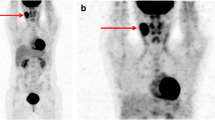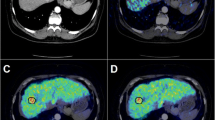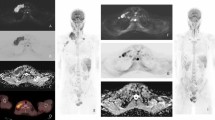Abstract
Purpose
The purpose of this study was to determine the ability of dual time-point (DTP) PET/CT with 18F-FDG to discriminate between malignant and benign lymphadenopathies. The relationship between DTP FDG uptake and glucose metabolism/hypoxia markers in lymphadenopathies was also assessed.
Methods
Patients with suspected lymphoma or recently diagnosed treatment-naive lymphoma were prospectively enrolled for DTP FDG PET/CT (scans 60 min and 180 min after FDG administration). FDG-avid nodal lesions were segmented to yield volume and standardized uptake values (SUV), including SUVmax, SUVmean, cSUVmean (with partial volume correction), total lesion glycolysis (TLG) and cTLG (with partial volume correction). Expression of glucose transporter-1 (GLUT-1), hexokinase-II (HK-II), glucose-6-phosphatase (G6Pase) and hypoxia-inducible factor-1alpha (HIF-1alpha) were assessed with immunohistochemistry and enzyme activity was determined for HK and G6Pase.
Results
FDG uptake was assessed in 203 lesions (146 malignant and 57 benign). Besides volume, there were significant increases over time for all parameters, with generally higher levels in the malignant lesions. The retention index (RI) was not able to discriminate between malignant and benign lesions. Volume, SUVmax, TLG and cTLG for both scans were able to discriminate between the two groups statistically, but without complete separation. Glucose metabolism/hypoxia markers were assessed in 15 lesions. TLG and cTLG were correlated with GLUT-1 expression on the 60-min scan. RI-max and RI-mean and SUVmax, SUVmean and cSUVmean on the 60-min scan were significantly correlated with HK-II expression.
Conclusion
RI was not able to discriminate between malignant and benign lesions, but some of the SUVs were able to discriminate on the 60-min and 180-min scans. Furthermore, FDG uptake was correlated with GLUT-1 and HK-II expression.






Similar content being viewed by others
References
Cheson BD, Fisher RI, Barrington SF, Cavalli F, Schwartz LH, Zucca E, et al. Recommendations for initial evaluation, staging, and response assessment of Hodgkin and non-Hodgkin lymphoma: the Lugano classification. J Clin Oncol. 2014;32(27):3059–68. doi:10.1200/jco.2013.54.8800.
Kwee TC, Basu S, Saboury B, Ambrosini V, Torigian DA, Alavi A. A new dimension of FDG-PET interpretation: assessment of tumor biology. Eur J Nucl Med Mol Imaging. 2011;38(6):1158–70. doi:10.1007/s00259-010-1713-9.
Bakheet SM, Powe J. Benign causes of 18-FDG uptake on whole body imaging. Semin Nucl Med. 1998;28(4):352–8.
Hustinx R, Smith RJ, Benard F, Rosenthal DI, Machtay M, Farber LA, et al. Dual time point fluorine-18 fluorodeoxyglucose positron emission tomography: a potential method to differentiate malignancy from inflammation and normal tissue in the head and neck. Eur J Nucl Med. 1999;26(10):1345–8.
Zhuang H, Pourdehnad M, Lambright ES, Yamamoto AJ, Lanuti M, Li P, et al. Dual time point 18F-FDG PET imaging for differentiating malignant from inflammatory processes. J Nucl Med. 2001;42(9):1412–7.
Basu S, Kung J, Houseni M, Zhuang H, Tidmarsh GF, Alavi A. Temporal profile of fluorodeoxyglucose uptake in malignant lesions and normal organs over extended time periods in patients with lung carcinoma: implications for its utilization in assessing malignant lesions. Q J Nucl Med Mol Imaging. 2009;53(1):9–16.
Cheng G, Alavi A, Lim E, Werner TJ, Del Bello CV, Akers SR. Dynamic changes of FDG uptake and clearance in normal tissues. Mol Imaging Biol. 2013;15(3):345–52. doi:10.1007/s11307-012-0600-0.
Basu S, Kwee TC, Surti S, Akin EA, Yoo D, Alavi A. Fundamentals of PET and PET/CT imaging. Ann N Y Acad Sci. 2011;1228(1):1–18.
Pauwels EK, Ribeiro MJ, Stoot JH, McCready VR, Bourguignon M, Maziere B. FDG accumulation and tumor biology. Nucl Med Biol. 1998;25(4):317–22.
Gallagher BM, Fowler JS, Gutterson NI, MacGregor RR, Wan CN, Wolf AP. Metabolic trapping as a principle of radiopharmaceutical design: some factors responsible for the biodistribution of [18F] 2-deoxy-2-fluoro-D-glucose. J Nucl Med. 1978;19(10):1154–61.
Zagorska A, Dulak J. HIF-1: the knowns and unknowns of hypoxia sensing. Acta Biochim Pol. 2004;51(3):563–85.
Boellaard R, Delgado-Bolton R, Oyen WJ, Giammarile F, Tatsch K, Eschner W, et al. FDG PET/CT: EANM procedure guidelines for tumour imaging: version 2.0. Eur J Nucl Med Mol Imaging. 2015;42(2):328–54. doi:10.1007/s00259-014-2961-x.
Bradford MM. A rapid and sensitive method for the quantitation of microgram quantities of protein utilizing the principle of protein-dye binding. Anal Biochem. 1976;72:248–54.
Taussky HH, Shorr E. A microcolorimetric method for the determination of inorganic phosphorus. J Biol Chem. 1953;202(2):675–85.
Meignan M, Gallamini A, Itti E, Barrington S, Haioun C, Polliack A. Report on the Third International Workshop on Interim Positron Emission Tomography in Lymphoma held in Menton, France, 26-27 September 2011 and Menton 2011 consensus. Leuk Lymphoma. 2012;53(10):1876–81. doi:10.3109/10428194.2012.677535.
Kim J, Hong J, Kim SG, Hwang KH, Kim M, Ahn HK, et al. Prognostic value of metabolic tumor volume estimated by (18)F-FDG positron emission tomography/computed tomography in patients with diffuse large B-cell lymphoma of stage II or III disease. Nucl Med Mol Imaging. 2014;48(3):187–95. doi:10.1007/s13139-014-0280-6.
Vera P, Modzelewski R, Hapdey S, Gouel P, Tilly H, Jardin F, et al. Does enhanced CT influence the biological GTV measurement on FDG-PET images? Radiother Oncol. 2013;108(1):86–90. doi:10.1016/j.radonc.2013.03.024.
Lodge MA, Chaudhry MA, Wahl RL. Noise considerations for PET quantification using maximum and peak standardized uptake value. J Nucl Med. 2012;53(7):1041–7. doi:10.2967/jnumed.111.101733.
Shinya T, Fujii S, Asakura S, Taniguchi T, Yoshio K, Alafate A, et al. Dual-time-point F-18 FDG PET/CT for evaluation in patients with malignant lymphoma. Ann Nucl Med. 2012;26(8):616–21. doi:10.1007/s12149-012-0619-y.
Nakayama M, Okizaki A, Ishitoya S, Sakaguchi M, Sato J, Aburano T. Dual-time-point F-18 FDG PET/CT imaging for differentiating the lymph nodes between malignant lymphoma and benign lesions. Ann Nucl Med. 2013;27(2):163–9. doi:10.1007/s12149-012-0669-1.
Khandani AH, Dunphy CH, Meteesatien P, Dufault DL, Ivanovic M, Shea TC. Glut1 and Glut3 expression in lymphoma and their association with tumor intensity on 18F-fluorodeoxyglucose positron emission tomography. Nucl Med Commun. 2009;30(8):594–601.
Watanabe Y, Suefuji H, Hirose Y, Kaida H, Suzuki G, Uozumi J, et al. 18F-FDG uptake in primary gastric malignant lymphoma correlates with glucose transporter 1 expression and histologic malignant potential. Int J Hematol. 2013;97(1):43–9.
Shim HK, Lee WW, Park SY, Kim H, Kim SE. Relationship between FDG uptake and expressions of glucose transporter type 1, type 3, and hexokinase-II in Reed-Sternberg cells of Hodgkin lymphoma. Oncol Res. 2009;17(7):331–7.
Torigian DA, Lopez RF, Alapati S, Bodapati G, Hofheinz F, van den Hoff J, et al. Feasibility and performance of novel software to quantify metabolically active volumes and 3D partial volume corrected SUV and metabolic volumetric products of spinal bone marrow metastases on 18F-FDG-PET/CT. Hell J Nucl Med. 2011;14(1):8–14.
Cheng G, Torigian DA, Zhuang H, Alavi A. When should we recommend use of dual time-point and delayed time-point imaging techniques in FDG PET? Eur J Nucl Med Mol Imaging. 2013;40(5):779–87. doi:10.1007/s00259-013-2343-9.
Chong EA, Torigian D, Svoboda J, Dwivedy Nasta S, Alavi A, Schuster SJ. Dual time point FDG-PET/CT imaging can distinguish between Hodgkin lymphoma and diffuse large B-cell lymphoma. Blood. 2014;124(21):1613.
Yamada T, Uchida M, Kwang-Lee K, Kitamura N, Yoshimura T. Correlation of metabolism/hypoxia markers and fluorodeoxyglucose uptake in oral squamous cell carcinomas. Oral Surg Oral Med Oral Pathol Oral Radiol. 2012;113(4):464–71.
Takahashi Y, Akahane T, Yamamoto D, Nakamura H, Sawa H, Nitta K, et al. Correlation between positron emission tomography findings and glucose transporter 1, 3 and L-type amino acid transporter 1 mRNA expression in primary central nervous system lymphomas. Mol Clin Oncol. 2014;2(4):525–9.
Hirose Y, Suefuji H, Kaida H, Hayakawa M, Hattori S, Kurata S, et al. Relationship between 2-deoxy-2-[(18)F]-fluoro-d-glucose uptake and clinicopathological factors in patients with diffuse large B-cell lymphoma. Leuk Lymphoma. 2014;55(3):520–5. doi:10.3109/10428194.2013.807509.
Shim HK, Lee WW, Park SY, Kim H, So Y, Kim SE. Expressions of glucose transporter types 1 and 3 and hexokinase-II in diffuse large B-cell lymphoma and other B-cell non-Hodgkin’s lymphomas. Nucl Med Biol. 2009;36(2):191–7.
Koga H, Matsuo Y, Sasaki M, Nakagawa M, Kaneko K, Hayashi K, et al. Differential FDG accumulation associated with GLUT-1 expression in a patient with lymphoma. Ann Nucl Med. 2003;17(4):327–31.
Fang J, Luo XM, Yao HT, Zhou SH, Ruan LX, Yan SX. Expression of glucose transporter-1, hypoxia-inducible factor-1alpha, phosphatidylinositol 3-kinase and protein kinase B (Akt) in relation to [(18)F]fluorodeoxyglucose uptake in nasopharyngeal diffuse large B-cell lymphoma: a case report and literature review. J Int Med Res. 2010;38(6):2160–8.
Pinto A, Gattei V, Zagonel V, Aldinucci D, Degan M, De Iuliis A, et al. Hodgkin’s disease: a disorder of dysregulated cellular cross-talk. Biotherapy. 1998;10(4):309–20.
Petrasch S, Kosco M, Perez-Alvarez C, Schmitz J, Brittinger G. Proliferation of non-Hodgkin-lymphoma lymphocytes in vitro is dependent upon follicular dendritic cell interactions. Br J Haematol. 1992;80(1):21–6.
Higashi T, Saga T, Nakamoto Y, Ishimori T, Mamede MH, Wada M, et al. Relationship between retention index in dual-phase 18F-FDG PET, and hexokinase-II and glucose transporter-1 expression in pancreatic cancer. J Nucl Med. 2002;43(2):173–80.
Boellaard R. Standards for PET image acquisition and quantitative data analysis. J Nucl Med. 2009;50 Suppl 1:11s–20. doi:10.2967/jnumed.108.057182.
Acknowledgments
We would like to thank the Departments of Nuclear Medicine, Haematology, Ear, Nose and Throat, and Pathology of Odense University Hospital for making this study possible. Special thanks are due to Marianne Knudsen and Henrik Petersen for making the recruiting of patients possible and helping with all the logistic challenges, to Christian Godballe and the secretaries of the Department of Ear, Nose and Throat for helping with the recruitment of patients, to Ole Nielsen and Lisbet Mortensen of the Department of Pathology for immunohistochemistry staining of the samples and to the physicists of the Department of Nuclear Medicine for helping with technical difficulties. Last but not least, we thank the Danish Council for Independent Research for funding this study (grant no. 4092-00378B).
Author information
Authors and Affiliations
Corresponding author
Ethics declarations
Funding
This study was funded by a grant from the Danish Council for Independent Research (grant no. 4092-00378B).
Conflicts of interest
None.
Ethical approval
All procedures performed in studies involving human participants were in accordance with the ethical standards of the institutional and/or national research committee and with the principles of the 1964 Declaration of Helsinki and its later amendments or comparable ethical standards.
Informed consent
Informed consent was obtained from all individual participants included in the study.
Electronic supplementary material
Below are the links to the electronic supplementary material.
Online Resource 1
(PDF 390 kb)
Online Resource 2
(PDF 133 kb)
Online Resource 3
(PDF 90 kb)
Rights and permissions
About this article
Cite this article
Christlieb, S.B., Strandholdt, C.N., Olsen, B.B. et al. Dual time-point FDG PET/CT and FDG uptake and related enzymes in lymphadenopathies: preliminary results. Eur J Nucl Med Mol Imaging 43, 1824–1836 (2016). https://doi.org/10.1007/s00259-016-3385-6
Received:
Accepted:
Published:
Issue Date:
DOI: https://doi.org/10.1007/s00259-016-3385-6




